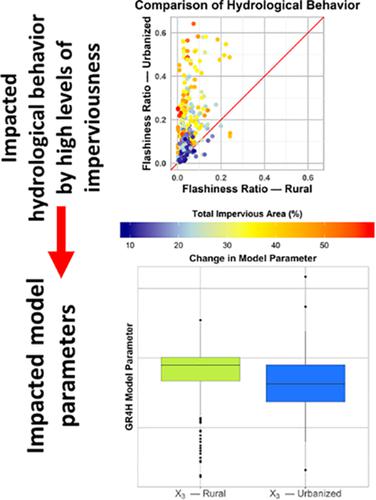当前位置:
X-MOL 学术
›
Hydrol. Process.
›
论文详情
Our official English website, www.x-mol.net, welcomes your
feedback! (Note: you will need to create a separate account there.)
Crossing the rural–urban boundary in hydrological modelling: How do conceptual rainfall–runoff models handle the specificities of urbanized catchments?
Hydrological Processes ( IF 2.8 ) Pub Date : 2020-06-12 , DOI: 10.1002/hyp.13808 Mohamed Saadi 1 , Ludovic Oudin 1 , Pierre Ribstein 1
Hydrological Processes ( IF 2.8 ) Pub Date : 2020-06-12 , DOI: 10.1002/hyp.13808 Mohamed Saadi 1 , Ludovic Oudin 1 , Pierre Ribstein 1
Affiliation

|
Landscape differences induced by urbanization have prompted hydrologists to define a fuzzy boundary between rural‐ and urban‐specific hydrological models. We addressed the validity of establishing this boundary, by testing two rural models on a large sample of 175 French and United States (US) urbanized catchments, and their 175 rural neighbours. The impact of urbanization on the hydrological behaviour was checked using four metrics. Using a split‐sample test, we have compared the performances, parameter distributions, and internal fluxes of GR4H and IHACRES, two conceptual and continuous models running at the hourly time step. Both model structures are based on soil moisture accounting reservoirs (infiltration, runoff, and actual evapotranspiration) and quick flow/slow flow routing components, with no consideration of any specific feature related to urbanization. Results showed: (a) Except for the ratio of streamflow flashiness to precipitation flashiness, the range of hydrological signature metrics in rural catchments encompassed the specificities of urbanized ones. Overall, the urbanized catchments showed higher ratios of mean streamflow to mean precipitation (median values: 0.39 vs. 0.27) and streamflow flashiness to precipitation flashiness (0.13 vs. 0.03), besides lower baseflow index (0.42 vs. 0.62) and shorter characteristic response time (3 vs. 14 hr). (b) The performances of GR4H revealed no significant distinction between rural and urbanized catchments in terms of Kling–Gupta Efficiency (KGE), whereas IHACRES better simulated urbanized catchments, especially during summer. (c) With respect to differences in urbanization level, the GR4H and IHACRES parameters showed different distributions. The differences in parameters were consistent with the differences in hydrological behaviour, which is promising for a model‐based assessment of the impact of urbanization. (d) The models agreed less in reproducing the internal fluxes over the urbanized catchments than over the rural ones. These results demonstrate the flexibility of conceptual models to handle the specificities of urbanized catchments.
中文翻译:

在水文模型中跨越城乡边界:概念性降雨-径流模型如何处理城市化集水区的特殊性?
由城市化引起的景观差异促使水文学家在农村和城市特定的水文模型之间定义了模糊的边界。我们通过在175个法国和美国(美国)城市化集水区及其175个农村邻国的大量样本上测试了两个农村模型,探讨了建立此边界的有效性。使用四个指标检查了城市化对水文行为的影响。使用分割样本测试,我们比较了GR4H和IHACRES的性能,参数分布和内部通量,这两个概念模型是在每小时的时间步长运行的。两种模型结构均基于土壤水分核算储层(入渗,径流和实际蒸散量)以及快速流/慢流路径要素,不考虑与城市化有关的任何特定特征。结果表明:(a)除流域水量与降水量的比率外,农村流域水文特征指标的范围还包括城市化流域的特殊性。总体而言,城市化集水区的平均流量与平均降水的比率较高(中位数值:0.39 vs. 0.27),流量闪耀与降水闪耀的比率(0.13 vs. 0.03),基础流量指数较低(0.42 vs. 0.62),特征响应较短。时间(3对14小时)。(b)GR4H的性能显示,在克林古普塔效率(KGE)方面,农村集水区和城市集水区之间没有显着区别,而IHACRES更好地模拟了城市集水区,特别是在夏季。(c)关于城市化水平的差异,GR4H和IHACRES参数显示不同的分布。参数的差异与水文行为的差异是一致的,这有望用于基于模型的城市化影响评估。(d)这些模型在复制城市化集水区的内部通量方面比在农村集水区上的一致较少。这些结果证明了概念模型在处理城市化流域特性方面的灵活性。
更新日期:2020-06-12
中文翻译:

在水文模型中跨越城乡边界:概念性降雨-径流模型如何处理城市化集水区的特殊性?
由城市化引起的景观差异促使水文学家在农村和城市特定的水文模型之间定义了模糊的边界。我们通过在175个法国和美国(美国)城市化集水区及其175个农村邻国的大量样本上测试了两个农村模型,探讨了建立此边界的有效性。使用四个指标检查了城市化对水文行为的影响。使用分割样本测试,我们比较了GR4H和IHACRES的性能,参数分布和内部通量,这两个概念模型是在每小时的时间步长运行的。两种模型结构均基于土壤水分核算储层(入渗,径流和实际蒸散量)以及快速流/慢流路径要素,不考虑与城市化有关的任何特定特征。结果表明:(a)除流域水量与降水量的比率外,农村流域水文特征指标的范围还包括城市化流域的特殊性。总体而言,城市化集水区的平均流量与平均降水的比率较高(中位数值:0.39 vs. 0.27),流量闪耀与降水闪耀的比率(0.13 vs. 0.03),基础流量指数较低(0.42 vs. 0.62),特征响应较短。时间(3对14小时)。(b)GR4H的性能显示,在克林古普塔效率(KGE)方面,农村集水区和城市集水区之间没有显着区别,而IHACRES更好地模拟了城市集水区,特别是在夏季。(c)关于城市化水平的差异,GR4H和IHACRES参数显示不同的分布。参数的差异与水文行为的差异是一致的,这有望用于基于模型的城市化影响评估。(d)这些模型在复制城市化集水区的内部通量方面比在农村集水区上的一致较少。这些结果证明了概念模型在处理城市化流域特性方面的灵活性。











































 京公网安备 11010802027423号
京公网安备 11010802027423号